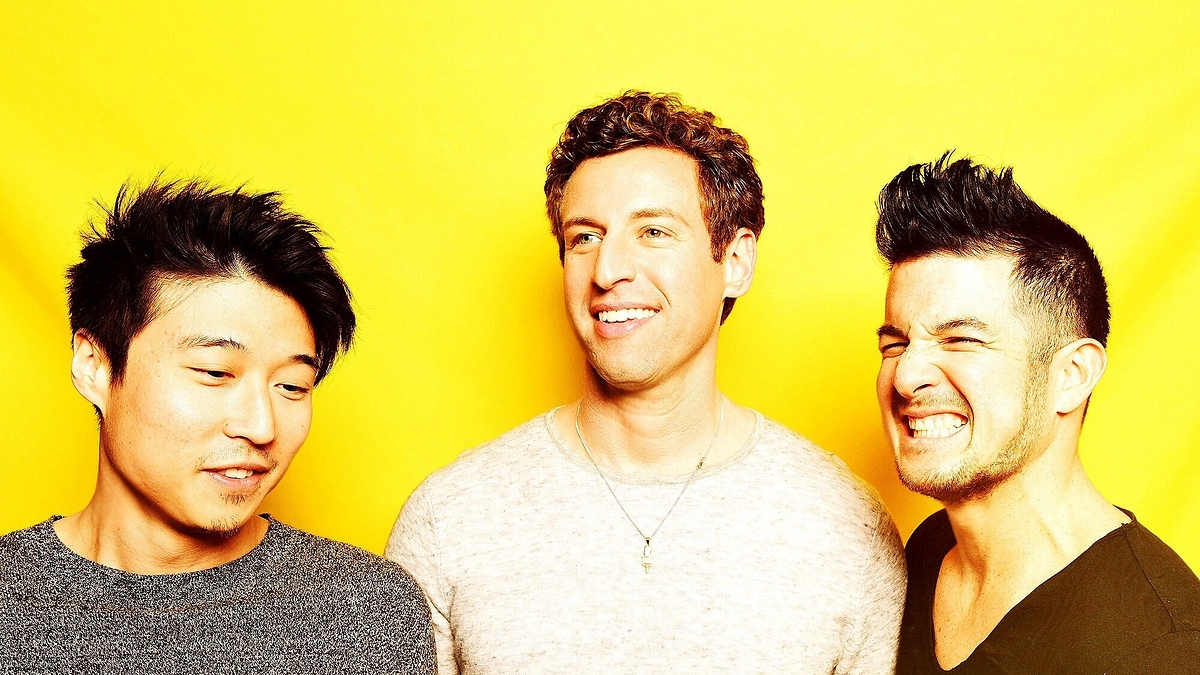
Time for Three.
In introducing Thursday Night’s New Haven Symphony Orchestra program in Woolsey Hall, Music Director Alisdair Neale cut to the chase. “Both these works feature a lot of art — without artifice,” he said, referencing their emotional immediacy. The program, featuring Grammy-winning trio Time for Three as something along the lines of a group of concerto-grosso soloists, featured two works by American composers, both of which presented a more romantic vision of orchestral music.
The first piece, the Suite from Appalachian Spring, by Aaron Copland, has become a mainstay of the orchestral repertoire for good reason, declaring a firmly American voice through the orchestral medium, with clear melody, invigorating flourishes of orchestral texture, and some wide-open textures that serve as a form of sound painting. In a sense the piece has been made a cliche, given that it has often had the task of representing the whole of American orchestral music.
But on Thursday night, the New Haven Symphony Orchestra delivered an excellent reading of the piece, taking none of it for granted — even the most famous and extractable section, the variations on the Shaker hymn “Simple Gifts.”
From the opening establishing A major chords, lone melodies emerged, creating tension from the major-seventh harmonies and upper harmonic voicings that flitted in and out as the chords were steadily revoiced. A rousing melody from the upper strings seemed to call from the past, while the more restless response from the remainder of the orchestra was delivered in a more modernist language.
A lot of tension was created through the harmonic language — sometimes placing one chord against a bass note that deliberately didn’t match, or having melodic ideas almost dueling in different keys simultaneously. This had an almost bridling effect on the optimism of the earlier piece, some necessary complexity amidst the overwhelming number of gorgeous moments within the score.
The fact of the piece being a suite meant that each of the sections felt somewhat disconnected, even as they proceeded with a similar structure, starting still, establishing a scene, and slowly building up energy. The chief connection between them is in the musical language, and the sense of place and narrative of each movement.
For modern audiences introduced to the piece by Thursday’s concert, there was a sense that Appalachian Spring explained a lot about what is probably most of America’s first association with the orchestra: film scores.
Yury, seeing the NHSO for the first time, said this was the first time he’d ever seen American music performed by an orchestra. “I thought: I’ve heard a lot of this type of sound in music for American movies — it was very refreshing for me, coming from a European background.”
Mia and Ryan, who were also seeing the orchestra for the first time, were similarly struck by the sonic language and imagery.
Mia: “There’s so many different colors — the opening and closing — so Copland, just a wash of tones. The orchestra really captured the imagery and character of each section in a really great way.”
Ryan: “Seconded”
After intermission, the orchestra resumed with “Contact” by the composer Kevin Puts, written for the group Time for Three, who joined the orchestra on stage to perform it. Featuring Charles Yang and Nicolas Kendall on violins and Ranaan Meyer on double bass, with all three singing, the group served as an effective section within the larger orchestral texture.
Given the volume discrepancies between three solo strings and a full concert orchestra, the trio was amplified — not a problem with the hand of a professional sound engineer, but definitely less than favorable in the type of acoustically viable spaces often desired for classical music. In some heightened moments, the trio felt fully apart from the orchestra, sometimes masking quieter happenings from other sections, despite all performers navigating the challenges of the piece with ease.
The trio began singing, with a simple chord progression in clean tone, before oboe took over the melody with first violins initially harmonizing, before the remainder of the orchestra joined. The harmonies were lush and mostly tonal, with bubbling and jerky rhythms in the bass propelling the almost floating theme. As the initial vocal statement returned, the orchestra harmonized it in a more confrontational way, framing it askew and developing the simple idea to greater heights.
The final movement featured some Balkan-inspired dance rhythms in 11/8, written seemingly to give the trio a moment to demonstrate some of their influences outside of the classical realm. While it initially seemed disconnected from earlier movements, it became an unstable backdrop for the return of the opening choral motif. Close to the end of the movement, the trio moved into a longer unaccompanied section, showing their interplay and instrumental harmony as they each dug into double-stop chords, sonically a significant moment in the piece.
Audiences responded well to the rock concert-like energy Time for Three brought to Woolsey Hall on Thursday. Returning to his vocal mic, Yang asked the audience how they were doing tonight, banter much more common to the pop world than the classical stage. Throughout their performance of “Contact,” the trio delivered the music with restless body language while performing, almost hallucinatory in its expressiveness. They subverted the norms of concert dress with designer sweaters and pristine white sneakers. They made it clear to the audience that they were having a good time.
The trio’s encore — consisting of an orchestral pop song written for the group, a cover of “Stand by Me” by Ben E. King, and a frenetic medley that wove together pop tunes with a reference to Looney Tunes animation — was an apt demonstration of their abilities. It was also a hard pivot from the character of the programmed works, a digestif that didn’t exactly aid digestion of the main course. But at that point the audience was fully along for the ride, singing and clapping at the performers’ direction.

At first I thought of NRBQ